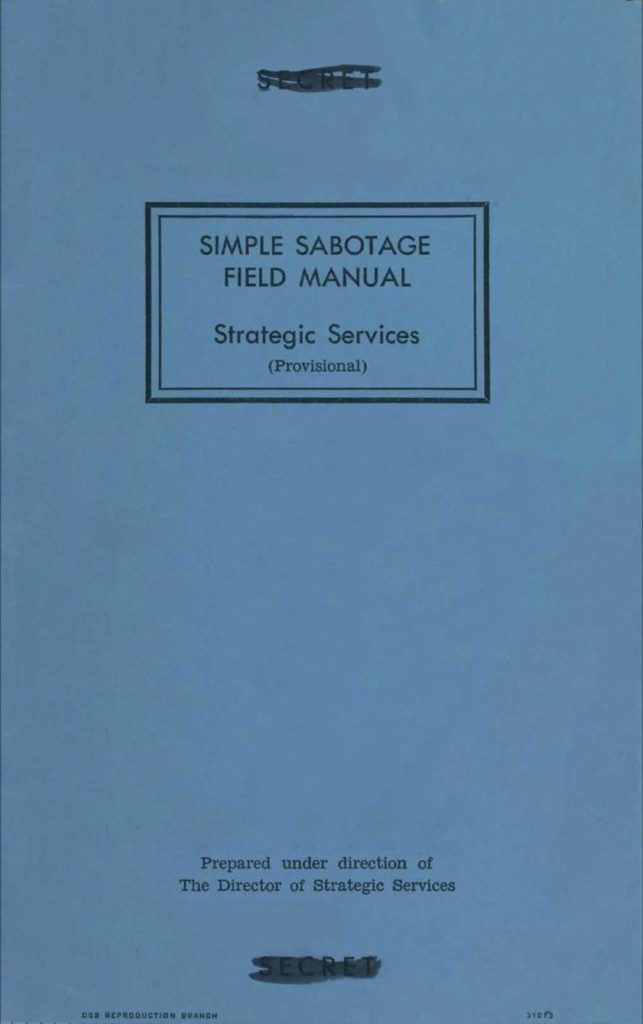BY ANDY BURNSIDE (he/they) CO-LEAD CISCO SECURE PRIDE
01/12/2023 20:09 PM ET (shared with authors permission)
I recently ran across a blog that highlighted several tips the CIA provided in a field manual written in 1944 to would-be saboteurs in occupied Europe on how to disrupt workplace productivity. Almost 80 years later, there are still valuable lessons, particularly for diversity and inclusion and workplace cultures wishing to create psychological safety and high performing teams.
Many of the themes from the field manual involve creating silos, slowing down decisions and time to action through unnecessary meetings, processes, and reviews, obfuscating effort and results with redundancy, minutiae, and banality. Often times overreliance on formality and tradition, as well as playing the fool and feet dragging, are likewise used to hide a lack of effective decision-making and transparency.
In terms of productivity management specifically, a sure sign of failure is the mis-prioritization of unimportant work, insistence on reworking finished products, and shipping defective products. And culturally speaking, an inability to properly train your employees, unfairly rewarding less efficient employees while discriminating against harder working staff and wasting resources at events and conferences when more critical work remains undone are all recipes for disaster.
In an environment ripe for corporate sabotage you may also find individuals who take opportunities to both follow regulations to the letter of law while other times using regulations and their “misunderstanding” of them as an excuse to delay work. You’ll likewise find these workplaces full of blame, for instance, the processes, tools, or equipment are all to blame, rather than there being accountability, and you will find difficulty with skills sharing between employees.
Here’s a list of 20 tips directly from the Simple Sabotage Field Manual:
- Insist on doing everything through “channels.” Never permit short-cuts to be taken in order to expedite decisions.
- Make “speeches.” Talk as frequently as possible and at great length.
- When possible, refer all matters to committees, for “further study and consideration.” Attempt to make the committees as large as possible—never less than five.
- Bring up irrelevant issues as frequently as possible.
- Haggle over precise wordings of communications, minutes, resolutions.
- Refer back to matters decided upon at the last meeting and attempt to re-open the question of the advisability of that decision.
- Demand written orders.
- “Misunderstand” orders. Ask endless questions or engage in long correspondence about such orders. Quibble over them when you can.
- Do everything possible to delay the delivery of orders. Even though parts of an order may be ready beforehand, don’t deliver it until it is completely ready.
- In making work assignments, always sign out the unimportant jobs first.
- Insist on perfect work in relatively unimportant products; send back for refinishing those which have the least flaw. Approve other defective parts whose flaws are not visible to the naked eye.
- When training new workers, give incomplete or misleading instructions.
- To lower morale and with it, production, be pleasant to inefficient workers; give them undeserved promotions. Discriminate against efficient workers; complain unjustly about their work.
- Hold conferences when there is more critical work to be done.
- Apply all regulations to the last letter.
- Do your work poorly and blame it on bad tools, machinery, or equipment. Complain that these things are preventing you from doing your job right.
- Never pass on your skill and experience to a new or less skillful worker.
- Snarl up administration in every possible way. Fill out forms illegibly so that they will have to be done over; make mistakes or omit requested information in forms.
- Give lengthy and incomprehensible explanations when questioned.
- Misunderstand all sorts of regulations concerning such matters as rationing, transportation, traffic regulations.
What can we learn about Psychological Safety from a WWII CIA Sabotage Manual?
We can learn so much, for starters, even though Agile methodology really only began in the early 2000’s we can see that the foundations of organizational leadership and management were thought out well before that time! The combination of agile throughout the entire business, aligning strategy, leadership, culture, ways of working, and more, is perhaps the most effective way to operate a business today. And because the same elements necessary for psychological safety are the building blocks of business agility, well, you can’t have one without the other!
Let’s take a look at how we can apply this manual to business agility:
Silos
First, one of the most important aspects of agility is breaking down organizational silos. Cross-functional teams are at the heart of Agile methodology and Business Agility. Building teams that are highly adaptive and can move throughout your organization to quickly acquire the resources, build, and ship your product is essential to business success! This doesn’t occur with teams in cumbersome hierarchies or matrixed organizations where resources are tied down to fixed parts of the org. When you have a team that can construct and deconstruct itself as it pulls work down from leadership you have the most efficient utilization of resources possible — and those teams don’t exist in silos — they’re ephemeral!
Accountability
Perhaps the next most important aspect of truly agile organizations is accountability. Because as you can imagine with all of these efficiencies and constant construction/deconstruction and rinse/repeat cycles there is very little room for micromanagement. Therefore, the system itself
When diversity, equity, inclusion and belonging practices are tightly connected to organizational purpose, it not only demonstrates how organizations are following through on these commitments, it embeds that commitment within your culture and aligns accountability to actions.
Why Effective DEIB Strategies Are Tightly Connected to Organizational Purpose, Dream Chua (they/them), Cornerstone
must achieve built-in accountability. Like the work, or effort, itself, accountability is pulled from the top of the organization down to the bottom. This means leadership must start by creating a vision, defining values, and communicating objectives and outcomes and allow them to be pulled down throughout the organization.
Transparency
Not to get too far away from a traditional reference to a structural model, but if silos and accountability are the first two most important aspects of an agile organization these are only achieved after being built upon a foundation of transparency. None of it works without transparency, you cannot pull work, accountability, or bridge the necessary cultural and communication requirements to construct, deconstruct, rinse and repeat in forming effective pods, scrums, squads, or whatever you decide to call them, without transparency at the base of it all!
But you wrote about Agile and never said Iteration or Sprint?!
It’s true, it’s all about the release, or as I like to say, it’s all about getting shit done. But whether you iterate every two days or two weeks, the combination of lightweight processes, consistency, and the transformative properties of cross-functional teams, accountability and transparency helps organizations align their culture, strategy, production and leadership in truly disruptive ways — and most importantly — it does so with real purpose!





